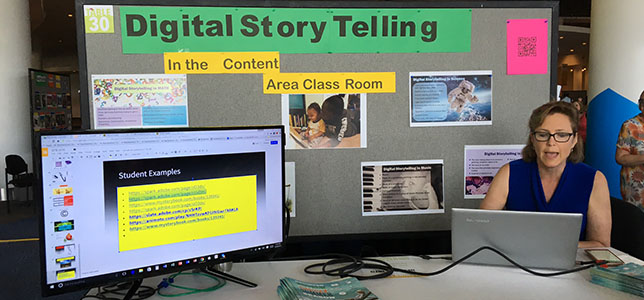Playground and Poster Sessions Push Teaching Forward

You’ve been to a conference and sat in the audience listening to a speaker or panel go on and on and on, right? And do you remember everything they said? Chances are, you don’t.
Sure, ISTE 2016, which concluded Wednesday in Denver, featured plenty of panels, too. Dozens of them. But a couple of the ingredients that made ISTE unique were what the conference called “Poster” and “Playground.”
Poster was an area of the Colorado Convention Center where teachers demonstrated technologies they’ve successfully used in the classroom.
Playground — on the same floor but in different areas — featured hands-on workshops with educators and students exploring everything from mobile learning and games to virtual reality and the maker movement.
“It makes it worthwhile for a lot of our members,” said Chris Luchs, associate dean of CTE in the Colorado Community College System and a program committee member of Playground. “One of the really cool things about this is,
this is where a lot of members can get a lot of one-on-one time with a lot of innovators that are at their grade level, that are in their area.”
Indeed, instructors varied in fields of study from science to math, career technical, English and philosophy.
Playgrounds included digital storytelling, librarians sharing favorite tools and resources, using computers to learn about STEM, learning about copyright and the Internet and trying out new and emerging technologies. Google had its own extensive Playground section, where folks in yellow Google T-shirts led sessions on Chromebooks, Cardboard, Expeditions, Google Certifications, virtual reality and going paperless.
“For me, it’s the chance to share some of the things I’ve learned over the years,” said Shannon Wentworth, an instructional technology teacher and trainer from Aurora, CO. “I can also see what other people did over the year. It’s a chance to catch up and learn from each other. There’s always someone who knows better about what’s happening.”
In the Poster area, teachers and students gave hundreds of demonstrations on integrating technology in the classroom and guiding others to do so, too. Each presenter was given a gray felt board to post visual materials onto – hence the name “Poster.”
Gretchen Sting, a fifth grade teacher from Medford, NJ, offered an example rich presentation titled “Digital Storytelling in the Content Area Classroom.” She showed how students can use Adobe Voice and other programs to tell multimedia stories in language arts, math, science, social studies, art and music.
Robert Kalman, an ed tech teacher from Westwood, NJ, demonstrated a game and code-making product called Bloxels. He illustrated how children could create a digital world using tiny colored blocks, solve problems and tell a story.
“It’s definitely introducing them to coding concepts,” he said. “It helps the see the connection between the physical and digital world. They learn to be creative. They learn the design process. They can experiment with innovative technologies. It allows them to tell a story in a different sort of medium than they’re used to.”
Ronald Abate, an associate professor at Cleveland State University, presented storyboards and film clips in his Poster, “Integrating the Writing Process Into Student Video Production.” In an ongoing project at an urban public school, students from sixth to 12th grade have learned how to organize and write down their thoughts, build storyboards and create short films from their ideas.
Julian Reed, an associate professor at Furman University in Greenville, SC, demonstrated “How Movement in Classrooms Improves Learning, Behavior and Assessment.” Through his company ActivEd and his new program Walkabouts, which debuted at ISTE, Reed has combined physical activity with state-approved lessons taught in the classroom.
“When we move, we learn, and we learn as we move,” he said. “We’re matching students with the content, and the content changes every time.”
Other Poster sessions included “Even K-2 Students Can Code,” “Honoring Native Roots: Online Resources for Learning About Native Americans,” “Newsroom on a Shoestring,” “Using Lego Builds to Create Comics for Teaching Prehispanic History,” “3D and Virtual Reality in the Classroom” and “30+ Ways to Use Your iPad for Personalized Professional Development.”
The Playground and Poster sessions occurred during the entire run of ISTE. They were all organized and run by volunteers. Participants came from most of the United States and as faraway as Canada and Mexico.
Sting said her digital story projects really get students interested in the subject matter and foster continued learning.
“I have students at the end of the year saying, ‘Can I do this for homework?’ Or they say to their partners, ‘Can we meet at Google Docs at 6:30 p.m.?’ I have their buy in. They want to make it matter.”
Playground and Poster are expected to continue at ISTE in 2017, which is taking place June 25-28 in San Antonio, TX.